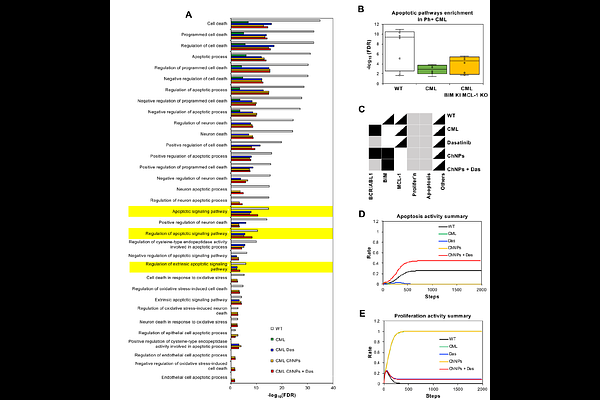Multimodal gene and targeted drug therapy for chronic myelogenous leukemia: Computational target analysis and therapeutic validation

Multimodal gene and targeted drug therapy for chronic myelogenous leukemia: Computational target analysis and therapeutic validation
Lugin, M. L.; Lei, W.; Lee, R. T.; Chung, J. Y.; Katritsis, N. M.; Hwang, W.; Fleischman, A. G.; Han, N.; Kwon, Y. J.
AbstractDeveloping an efficient and safe therapy necessitates a mechanistic understanding of the complex underlying pathology and manipulation of the multiple pathways at the molecular and genetic level. Network-based simulation of chronic myeloid leukemia (CML), a relatively well-understood cancer model, revealed the dynamics of simultaneously expressing pro-apoptotic BIM and silencing pro-survival MCL-1 in combination with the BCR-ABL-targeted tyrosine kinase inhibitor dasatinib. Viral/nonviral chimeric nanoparticles (ChNPs) composed of a BIM-expressing adeno-associated virus (AAV) core and a degradable polymeric shell that encapsulates MCL-1 siRNA (BIM/MCL-1 ChNPs) synergistically and selectively killed BCR-ABL+ CML cells in combination with dasatinib. In a mouse CML model, the BIM/MCL-1 ChNPs and dasatinib combination therapy suppressed proliferation of BCR-ABL+ hematopoietic cells and prevented leukemic infiltration of organs. The synergistic anti-leukemic effect was further pronounced in an acute phase model of the disease. This study investigated a strategy of developing a versatile and tunable multimodal therapy assisted by a computational toolset that analyzes the molecular foundation of a disease and predicts therapeutic response. The interdisciplinary approach developed and validated in this study can be used in discovering new therapies for cancer and other diseases.